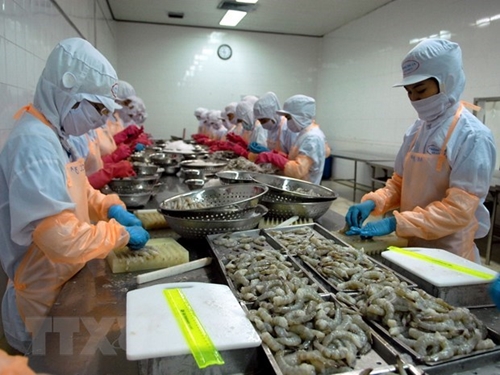They found themselves surrounded in difficulties last year as world supply saw strong increase that brought down both prices and demand in major markets. Besides, the US-China trade conflict also wreaked havoc on the shrimp sector. However, a brighter future is coming from the horizon to them this year thanks to a multitude of robust market signs.
The EU will remain a potential market for Vietnamese shrimp in the year as it is the largest shrimp consumer in the whole, while production of the bloc has not met its demand.
    |
 |
|
Shrimps processed for exports |
If Vietnamese exporters are able to take advantage of preferential tariff under the EU-Vietnam Free Trade Agreement (EVFTA), shrimp shipments to the bloc will possibly surge in 2020, experts have said.
Under the trade pact, signed on June 30, the tariffs of most raw shrimps (fresh, frozen and chilled) imported from Vietnam into the EU will be cut from the basic 12-20 percent to zero right after the deal comes into force. Besides, import taxes on processed shrimp will be brought to zero after seven years.
Vietnam has distinct advantage over its competitors, with import tariff of giant tiger prawns cut from 4.2 percent to zero under the Generalised System of Preferences Treatment (GSP), while that of frozen white-leg shrimp falling to zero after five years. Meanwhile, Thailand is not entitled to the GSP and has its shrimps levied with a basic tax rate of 12 percent.
Vietnamese shrimp exporters will have more opportunities in the US market, a leading destination, after the US Department of Commerce released the final results of the 13th period of review (POR 13) in August 2019, officially imposing zero percent tariff on 31 Vietnamese shrimp exporters.
Experts also foresee a surge in shipment to Japan – the host of the 2020 Olympic Games, hoping the event will promote shrimp consumption in this country.
As for the Chinese market, around 75-80 percent of Vietnamese seafood has been sold in the market via official channels, which serves as an important factor to enable market revival there.
In addition, another positive sign for the Vietnamese shrimp sector comes from several emerging markets like Australia, which are expected to maintain their import growth in 2020.
Last year, while shrimp shipments to major markets like the EU and Japan experienced a fall of 16.9 percent and 3.3 percent to 696.2 million USD and 618.6 million USD, respectively, the US and Australia increased their shrimp imports from Vietnam by 2.5 percent and 12.6 percent to 653.9 million USD and 121 million USD.
Source: VNA